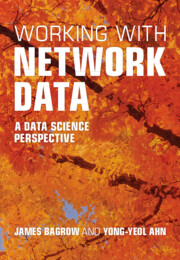Refine listing
Actions for selected content:
67 results in VLDB Books Chapter Collection
Part III - Fundamentals
-
- Book:
- Working with Network Data
- Published online:
- 06 June 2024
- Print publication:
- 13 June 2024, pp 315-316
-
- Chapter
-
- You have access
- Export citation
Chapter 6 - Gathering data
- from Part II - Applications, tools, and tasks
-
- Book:
- Working with Network Data
- Published online:
- 06 June 2024
- Print publication:
- 13 June 2024, pp 73-82
-
- Chapter
-
- You have access
- Export citation
Chapter 11 - Explore and explain: statistics for network data
- from Part II - Applications, tools, and tasks
-
- Book:
- Working with Network Data
- Published online:
- 06 June 2024
- Print publication:
- 13 June 2024, pp 137-164
-
- Chapter
-
- You have access
- Export citation
Chapter 14 - Summarizing and comparing networks
- from Part II - Applications, tools, and tasks
-
- Book:
- Working with Network Data
- Published online:
- 06 June 2024
- Print publication:
- 13 June 2024, pp 223-234
-
- Chapter
-
- You have access
- Export citation
Chapter 26 - Embedding and machine learning
- from Part III - Fundamentals
-
- Book:
- Working with Network Data
- Published online:
- 06 June 2024
- Print publication:
- 13 June 2024, pp 429-446
-
- Chapter
-
- You have access
- Export citation
Chapter 17 - Research record-keeping
- from Interlude — Good practices for scientific computing
-
- Book:
- Working with Network Data
- Published online:
- 06 June 2024
- Print publication:
- 13 June 2024, pp 283-288
-
- Chapter
-
- You have access
- Export citation
Part II - Applications, tools, and tasks
-
- Book:
- Working with Network Data
- Published online:
- 06 June 2024
- Print publication:
- 13 June 2024, pp 63-64
-
- Chapter
-
- You have access
- Export citation

Working with Network Data
- A Data Science Perspective
-
- Published online:
- 06 June 2024
- Print publication:
- 13 June 2024
-
- Book
-
- You have access
- Export citation
0 - Introduction
-
- Book:
- Gender and Technology at Work
- Published online:
- 28 March 2024
- Print publication:
- 04 April 2024, pp 1-22
-
- Chapter
-
- You have access
- HTML
- Export citation
1 - Introduction
-
- Book:
- Deep Learning for Natural Language Processing
- Published online:
- 01 February 2024
- Print publication:
- 08 February 2024, pp 1-7
-
- Chapter
-
- You have access
- Export citation
1 - Introduction to Privacy-preserving Computing
-
- Book:
- Privacy-preserving Computing
- Published online:
- 26 October 2023
- Print publication:
- 16 November 2023, pp 1-12
-
- Chapter
-
- You have access
- Export citation
1 - Introduction to Part I. Robo-advising as a Technological Platform for Optimization and Recommendations
- from Part I - Robo Advisors and Automated Recommendation
-
- Book:
- Machine Learning and Data Sciences for Financial Markets
- Published online:
- 12 May 2023
- Print publication:
- 01 June 2023, pp 5-8
-
- Chapter
-
- You have access
- Export citation
1 - Introduction
- from Part I - Preliminaries
-
- Book:
- Random Graphs and Networks: A First Course
- Published online:
- 02 March 2023
- Print publication:
- 09 March 2023, pp 3-7
-
- Chapter
-
- You have access
- Export citation
Introduction
-
- Book:
- Data Science in Context
- Published online:
- 29 September 2022
- Print publication:
- 20 October 2022, pp 1-4
-
- Chapter
-
- You have access
- HTML
- Export citation
1 - Introduction
-
- Book:
- Data Analytics for Cybersecurity
- Published online:
- 10 August 2022
- Print publication:
- 21 July 2022, pp 1-13
-
- Chapter
-
- You have access
- HTML
- Export citation
1 - Introduction
-
- Book:
- Control Systems and Reinforcement Learning
- Published online:
- 17 May 2022
- Print publication:
- 09 June 2022, pp 1-6
-
- Chapter
-
- You have access
- Export citation
1 - Introduction to GPU Kernels and Hardware
-
- Book:
- Programming in Parallel with CUDA
- Published online:
- 04 May 2022
- Print publication:
- 02 June 2022, pp 1-21
-
- Chapter
-
- You have access
- Export citation
1 - Introduction
-
- Book:
- Optimization for Data Analysis
- Published online:
- 31 March 2022
- Print publication:
- 21 April 2022, pp 1-14
-
- Chapter
-
- You have access
- Export citation
1 - Introduction
-
- Book:
- Data Visualization for Social and Policy Research
- Published online:
- 10 March 2022
- Print publication:
- 07 April 2022, pp 1-8
-
- Chapter
-
- You have access
- Export citation
1 - Basics
-
- Book:
- Computational Topology for Data Analysis
- Published online:
- 18 February 2022
- Print publication:
- 10 March 2022, pp 1-25
-
- Chapter
-
- You have access
- Export citation
